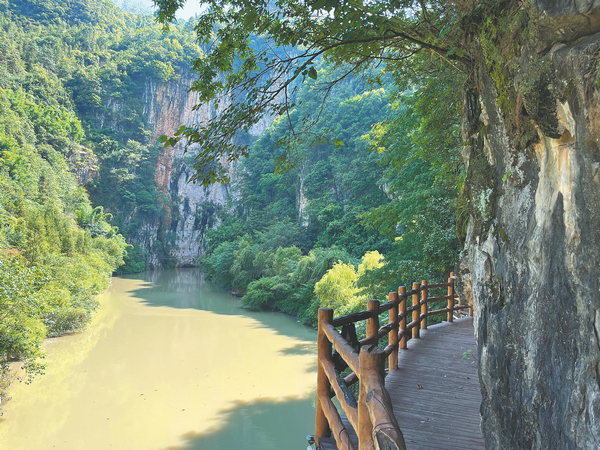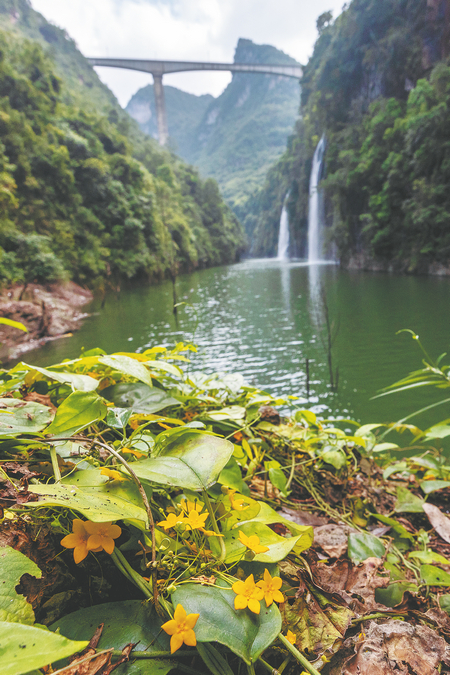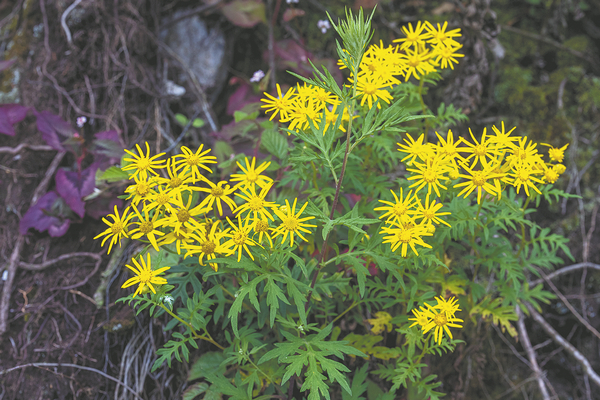
A path winds along a river and heads to a karst cave at the Niangniangshan scenic area in Panzhou, Guizhou province. CHEN LIANG/CHINA DAILY
Guizhou's stunning landscapes, and lack of crowds, make it a perfect place to lift the spirits, Chen Liang reports.
This year, domestic tourism is not just hot, it is sizzling. It seems that every popular tourist attraction is crowded and every hotel at a popular scenic area is charging top dollar.
To avoid joining the hordes of tourists — it's a challenge, believe me — you have to be patient and sometimes think creatively.
I stayed at home in Beijing in July and August, waiting for the end of the summer vacation. In September, two friends and I started thinking of finding a "cool" place to have a four- or five-day trip to get close to nature and regain our stamina, which had been consumed by the intense summer heat.
Located on the Yunnan-Guizhou Plateau, the two southwestern provinces that grabbed our attention offered cooler climes.
We had been to Yunnan province many times, including a trip earlier this year, so Guizhou province won the toss.
But, where in Guizhou? I asked a botanist friend, who spent a month there earlier this year collecting specimens, for some recommendations. He mentioned Chishui, Xingyi and Panzhou.
Chishui is more popular than Xingyi. My friends and I never heard of Panzhou. So it was decided; we would visit Panzhou. After some further research, we found that Panzhou borders Xingyi and can be easily reached by car from the provincial capital, Guiyang.
After Panzhou, we could visit Xingyi en route for Guiyang.
So three of us flew into Guiyang from different cities, met, picked up our car at the Longdongbao airport, and drove to Panzhou.

Wildflowers bloom on the bank of the Qingshui River against the backdrop of the Qingshui Bridge and two waterfalls. CHEN LIANG/CHINA DAILY
Taking the high road
I really enjoyed driving in Guizhou. Landlocked and known for extensive karst landforms, the province has developed rapidly in terms of its expressway infrastructure in the past decade.
By the end of 2021, the expressway network in the province exceeded more than 8,000 kilometers. Expressway journeys tripled from 2,630 km in 2012 to 8,010 km in 2021, and now rank fifth in the country. Nearly half of the world's 100 highest bridges are located in the province, according to the provincial government.
From Guiyang to Panzhou, a county in the southwestern corner of Guizhou, the drive was almost completely on the expressways, and we certainly crossed some of the high-altitude bridges.
It was hard to tell when we were driving on a bridge, as many sections of the Guizhou expressways are elevated, giving a sense of floating above ground.
As we traversed the expressways, we frequently caught glimpses of majestic karst pinnacles, with many towns' high-rises appearing dwarfed below.
Through the car windows, we would occasionally see clouds gracefully drifting by, adding a touch of ethereal beauty to our journey. We encountered few vehicles and it was a challenge to keep driving below the speed limit. After nearly four hours, and more than 300 km, we reached the county town of Panzhou.

A species of wild chrysanthemum in full bloom on the Laohei Mountain in Panzhou. CHEN LIANG/CHINA DAILY
Peaking our interest
It was hard to believe that a standard room in one of the best hotels in Panzhou was priced at only 210 yuan ($29).
Dinner, fresh beef hot pot at a nearby restaurant, was of exceptional value and very tasty at 180 yuan. The beef was tender and the sauce, which included chili pepper paste, was spicy and aromatic. Dipped in the sauce, the beef was mouthwateringly delicious.
Breakfast in a nearby rice noodle shop the next day was, incredibly, even better. Twelve yuan will get you a bowl of rice noodles in either beef or chicken soup. I spent another 10 yuan adding an egg and a chicken leg.
We headed to Laohei Mountain to be greeted by a landscape of rolling hills, right behind the county town, and wind turbines serenely going about their work.
To find the road up the mountain, we needed to search for Laoheishan Wind Farm in the navigation app. The narrow and winding road is newly paved, but easy to navigate and with few vehicles.
After 40 minutes, we reached the ridgeline of Laohei Mountain.
The hilltops are surprisingly wide and flat, with rocky slopes surrounding grassy meadows. Dense bushes grow rampant on the slopes. In September, many wild plants were still blooming, including a species of rhododendron shrub with big, white flowers and at least three species of impatiens with, respectively, yellow, white and red flowers.
The meadows, offering panoramic views of valleys, villages and the city at the foot of the hills, are ideal places to camp and have a picnic. Local people know this and many can be seen running stands that line the road, renting tents or barbecue equipment.
It was probably because it was a weekday that their business seemed quite slow.
We walked around several hilltop meadows, and climbed up three or four wind turbine platforms to enjoy the cool breeze and beautiful views before heading to the Niangniangshan scenic area in the afternoon.
After an hour's drive we arrived and realized that, hidden in a broad valley, the scenic area features many attractions, including a mountaintop park that can be reached by cable car, a few karst caves, sinkholes and a hot spring resort. It needs two or three days to explore.
We opted to instead pay the 20 yuan per person admission fee to see a river flowing from a karst cave along a winding trail on the steep river bank. It was a pleasant two-hour hike, shaded by the sheer karst cliffs and overgrown trees.
We then drove two hours to Xingyi in the southern part of Guizhou.
Viewing point
It seems that every visitor to Xingyi will go to the Maling River Canyon, a national-level scenic area, just 5 km from the county-level city, known for several waterfalls that cascade from karst cliffs. While having breakfast in our hotel, we heard other guests talking about the park.
We planned to visit the Maling River and part of the canyon, but not the park. We headed to the Qingshui River, the upper part of the Maling River, and the Qingshui River Canyon, about 40 minutes drive from Xingyi.
It was deserted, as we could drive directly to a viewing point overlooking the river and four waterfalls crashing down a cliff overgrown with deep-green ferns. It was isolated and no one bothered us.
The only downside is that it seems like nobody really takes care of the spot, as trash was strewed nearby.
From the viewing point, we could see the four cascades falling dozens of meters into the pristine river, which was spanned on the left by a railway bridge.
From time to time, a train emerged from a tunnel onto the bridge, before disappearing into another tunnel.
There is a stone stairway descending to the riverbank, which is about 100 meters below the viewing point. There we could look up to admire two waterfalls.
The scene was truly spectacular!
Later I found that the Qingshui Bridge, 360 meters long and standing 183 meters above the Qingshui River, was the world's highest railway bridge when it was put into use in 1996. We walked to it, but a railway worker told us that visitors are not allowed onto the bridge.
We then visited Jianxiequan, meaning "geyser", on the outskirts of Xingyi, another free scenic area, in the afternoon.
Hidden in a small wood, the geyser gushes out of a stone crevice on a karst slope, creating a winding stream. It flows into a pond with many big fish. There is a stone path around the pond, with pavilions and bridges standing near the clear spring water. The water then flows into a river curving around paddy fields. The scenery is quite idyllic and beautiful.
En route for Guiyang, we arrived at the entrance of a national-level attraction, but decided that, after hidden waterways of Xingyi, the Getu River in Anshun city was a bit too "main stream" for our tastes.














